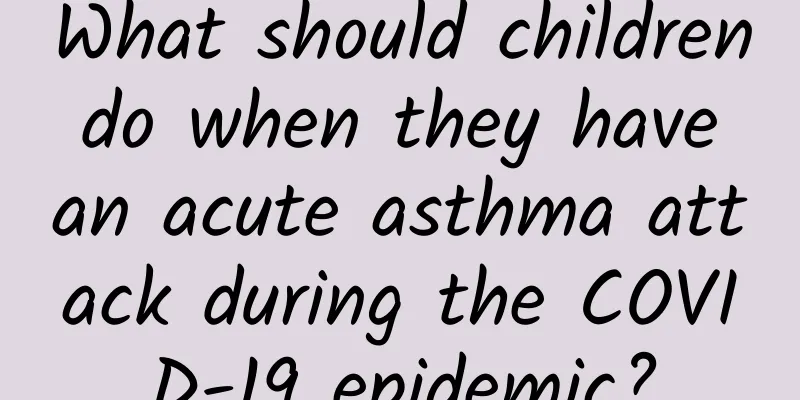What should children do when they have an acute asthma attack during the COVID-19 epidemic?

|
Author: Yu Xingmei Children's Hospital Affiliated to Suzhou University Zhang Xinxing, deputy chief physician of Children's Hospital of Suzhou University Reviewer: Hao Chuangli, Chief Physician, Children's Hospital Affiliated to Soochow University It is estimated that there are 339 million asthma patients in the world, and about 1,000 people die from asthma every day. In 2016, the number of deaths from asthma worldwide was 420,000. The mortality rate of childhood asthma is 0 to 0.7/100,000. For families with children with asthma, it is crucial to know how to properly handle acute attacks of asthma in children during the special period of epidemic prevention and control. This article will help parents understand the relevant knowledge of acute asthma attacks and emergency treatment from the aspects of understanding the precursors, manifestations, severity judgment and reasonable emergency treatment of childhood asthma attacks, as well as sequential management after the attack, so as to add another safety lock for children with asthma. 1. How to judge acute asthma attack in children Prodromal symptoms: runny nose, sneezing, coughing, and some children have symptoms such as chest tightness. Acute attack: Cough, wheezing, shortness of breath, and chest tightness that occur suddenly after exposure to the environment or irritants. If the above symptoms progressively worsen, it is considered an acute attack of asthma. Determining the severity of an asthma attack in children 1. If the child develops the above symptoms while at home, the severity of the situation should be assessed (see the table below) so that better treatment measures can be taken.
(1) The effects of quick-relief drugs do not last long or are completely ineffective, and breathing remains rapid and difficult. (2) Difficulty speaking due to asthma attack. (3) Gray or bluish lips or nails. (4) The nostrils flare when breathing. (5) The ribs and neck skin indent when breathing. (6) Heart rate and pulse are very fast. (7) Difficulty walking. Children's Asthma Severity Assessment Scale 3. Emergency treatment process for acute asthma attack in children at home 1. Process for treating acute asthma attacks in children with asthma at home (Figure 1) Figure 1 Copyright image, no permission to reprint 2. Home medication process (1) If conditions for nebulized administration are met, nebulized inhalation should be the first choice. Figure 2 Copyright image, no permission to reprint (2) When there is no nebulization condition, use a pressurized metered dose inhaler (pMDI) + storage tank. Figure 3 Copyright image, no permission to reprint Note: Spray a single dose each time, use 4 to 10 sprays continuously (3 to 6 sprays for children under 6 years old), 20 minutes × 3 times. 3. Post-treatment response assessment (1) Good response : mild wheezing, coughing, dyspnea or chest tightness; symptoms only occur during activity, but not at rest; repeat treatment every 3 to 4 hours as needed within 24 to 48 hours; continue with regular nebulization or inhalation treatment; contact a doctor if symptoms recur; make an appointment for outpatient follow-up. (2) General reaction : obvious wheezing, dyspnea or repeated coughing; symptoms also occur when resting; inhalation of β2 receptor agonists (Ventolin) every hour; oral glucocorticoids; if the condition does not improve within 2 to 6 hours, seek medical attention immediately. If symptoms worsen, go to the hospital emergency room or call 120 emergency number. (3) Poor response: severe wheezing and breathing difficulties, intermittent speech; severe symptoms persist even when resting; call 120 emergency number for emergency treatment. 4. Sequential management of children with asthma after an acute attack 1. Environmental management (1) Eliminate asthma triggers in your home: smoking, irritating odors, and pet hair. (2) Reduce the use of plush toys and carpets. (3) Clean bedding regularly. (4) Open windows for ventilation as appropriate. (5) Perform household chores when the patient is not at home. (6) Maintain a good work and rest schedule and get adequate exercise. 2. Medication management (1) Supervise patients to take medication correctly every day. (2) Peak flow rate can be monitored at home. (3) Do not stop taking medications to control asthma attacks without permission. 3. When children with asthma go out to play, they need to be equipped with the asthma emergency medicine salbutamol aerosol (Ventolin aerosol) to prepare for emergency treatment of sudden asthma attacks. |
Recommend
How long does it take for the lower abdomen to return to a flat state after childbirth?
After giving birth, the mother's abdomen will...
"How many people do you want to kill before you can put down the cigarette in your hand..."
Addendum 1: Do you know why secondhand smoke is m...
How can I have a miscarriage naturally when I just got pregnant?
Pregnancy itself is a very happy and joyful thing...
How to increase estrogen after menopause?
Whether the estrogen level is normal directly aff...
What to eat during the fifth month of pregnancy
For expectant mothers or pregnant women, they sho...
What does it mean that the domestic anti-COVID-19 drug was taken off the shelves within one day of its launch?
It came with the halo of "the first domestic...
Can stress affect pregnancy?
For couples who have been married for a year, if ...
Do you have small pimples on your face? Don’t take it lightly, you may be infected with HPV!
With the introduction of imported and domestic va...
How to strengthen your body after childbirth
Most mothers are weak right after giving birth, s...
Which has higher calories, grilled chicken or fried chicken? What are the dangers of grilling overnight?
Barbecue is a process of grilling meat and meat p...
The biomechanical effects of sensory sports insoles on children's gait in shoes
The biomechanical effects of sensory sports insol...
What causes vaginal bleeding?
Vaginal bleeding is a common symptom among women....
Gynecological examination showed inflammation but no feeling, what's going on?
Women may suffer from various gynecological disea...
What delicacies can be made with pumpkin and glutinous rice flour? The ratio of glutinous rice flour to pumpkin for pumpkin balls
Pumpkin balls can be steamed or fried after steam...
A complete picture of a woman's right foot with a mole
Don’t think that a mole is so small, but it has a...









